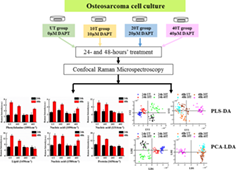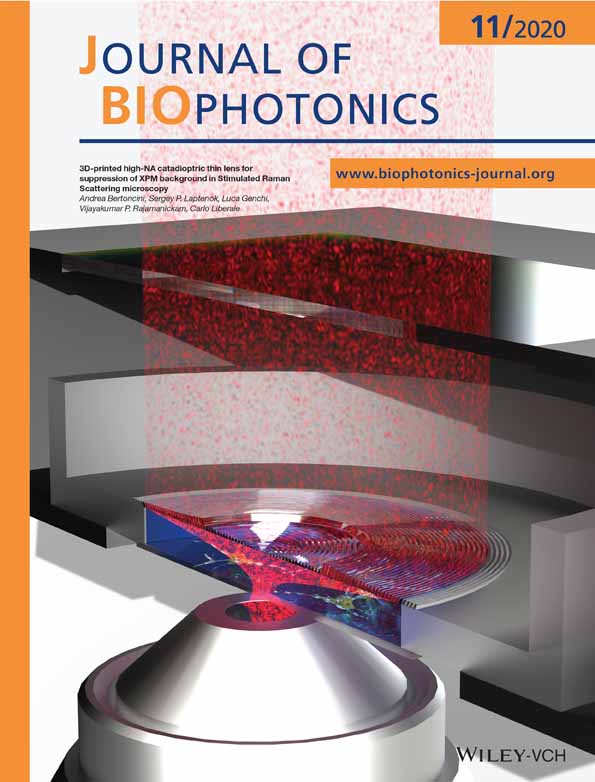Unveiling dose- and time-dependent osteosarcoma cell responses to the γ-secretase inhibitor, DAPT, by confocal Raman microscopy
Jie Li
Institute of Photonics and Photon-Technology, Northwest University, Xi'an, Shaanxi, China
Search for more papers by this authorJie Qin
Department of Orthopedics, The Second Affiliated Hospital of Xi'an Jiaotong University, Xi'an, Shaanxi, China
Search for more papers by this authorHaishan Zeng
Imaging Unit–Integrative Oncology Department, BC Cancer Research Center, Vancouver, BC, Canada
Search for more papers by this authorJing Li
Department of Orthopedics, The Second Affiliated Hospital of Xi'an Jiaotong University, Xi'an, Shaanxi, China
Search for more papers by this authorKaige Wang
Institute of Photonics and Photon-Technology, Northwest University, Xi'an, Shaanxi, China
Search for more papers by this authorCorresponding Author
Shuang Wang
Institute of Photonics and Photon-Technology, Northwest University, Xi'an, Shaanxi, China
Correspondence
Dr Shuang Wang, Associate Professor, Institute of Photonics and Photon-technology, Northwest University, #229 North Taibai Road, Xi'an, Shaanxi710069, China.
Email: [email protected]
Search for more papers by this authorJie Li
Institute of Photonics and Photon-Technology, Northwest University, Xi'an, Shaanxi, China
Search for more papers by this authorJie Qin
Department of Orthopedics, The Second Affiliated Hospital of Xi'an Jiaotong University, Xi'an, Shaanxi, China
Search for more papers by this authorHaishan Zeng
Imaging Unit–Integrative Oncology Department, BC Cancer Research Center, Vancouver, BC, Canada
Search for more papers by this authorJing Li
Department of Orthopedics, The Second Affiliated Hospital of Xi'an Jiaotong University, Xi'an, Shaanxi, China
Search for more papers by this authorKaige Wang
Institute of Photonics and Photon-Technology, Northwest University, Xi'an, Shaanxi, China
Search for more papers by this authorCorresponding Author
Shuang Wang
Institute of Photonics and Photon-Technology, Northwest University, Xi'an, Shaanxi, China
Correspondence
Dr Shuang Wang, Associate Professor, Institute of Photonics and Photon-technology, Northwest University, #229 North Taibai Road, Xi'an, Shaanxi710069, China.
Email: [email protected]
Search for more papers by this authorKie Li and Jie Qin contributed equally to this study.
Funding information: National Natural Science Foundation of China, Grant/Award Number: 61911530695; Natural Science Foundation of Shaanxi Province, Grant/Award Number: 2016ZDJC-15 S2018-ZC-TD-0061
Abstract
Using confocal Raman micro-spectroscopy, this study aims to elucidate the cellular responses of the γ-secretase inhibitor, N-[N-(3,5-difluorophenacetyl)-L-alanyl]-S-phenylglycine t-butyl ester (DAPT), in osteosarcoma (OS) cells in a dose- and time-dependent manner. The K7M2 murine OS cell line was treated with different DAPT doses (0, 10, 20, and 40 μM) for 24 and 48 hours before investigations. Significant compositional changes (nucleic acids, protein and lipid) after DAPT treatment were addressed, which testified inhibitory effect of DAPT on the growth of OS cells. Moreover, both partial least squares-discriminant analysis (PLS-DA) and principal component analysis-linear discriminant analysis (PCA-LDA) analyses revealed governing composition variations among groups by distinguishing their spectral characteristics. Furthermore, by adopting leave-one-out cross validation method, it is shown that PLS-DA exhibited more classification capacity than PCA-LDA algorithm. Hence, by understanding the DAPT-based cellular variations, the achieved results provided an experimental foundation to establish new DAPT-based anticancer therapeutic strategies, and preclinical Raman analytical methodologies on drug-cell interactions.
CONFLICT OF INTEREST
The authors declare no potential conflict of interest.
Supporting Information
| Filename | Description |
|---|---|
| jbio202000238-sup-0001-Tables.docxWord 2007 document , 20.8 KB | Table S1 Classification results obtained from Raman spectral prediction of osteosarcoma cells in UT, 10 T, 20 T, and 40 T groups at the 24-hour time point using the PLS-DA algorithm combined with the LOOCV method. Table S2. Classification results obtained from Raman spectral prediction of osteosarcoma cells in UT, 10 T, 20 T, and 40 T groups at the 48-hour time point using the PLS-DA algorithm combined with the LOOCV method. Table S3. Classification results obtained from Raman spectral prediction of osteosarcoma cells in UT, 10 T, 20 T, and 40 T groups at the 24-hour time point using the PCA-LDA algorithm combined with the LOOCV method. Table S4. Classification results obtained from Raman spectral prediction of osteosarcoma cells in UT, 10 T, 20 T, and 40 T groups at the 48-hour time point using the PCA-LDA algorithm combined with the LOOCV method. |
Please note: The publisher is not responsible for the content or functionality of any supporting information supplied by the authors. Any queries (other than missing content) should be directed to the corresponding author for the article.
REFERENCES
- 1G. Ottaviani, N. Jaffe, Cancer Treat. Res. 2009, 152, 3.
- 2S. Osasan, M. Zhang, F. Shen, P. Paul, S. Persad, C. Sergi, Anticancer Res 2016, 36, 4391.
- 3F. Zhang, T. Q. Yan, W. Guo, Journal of Peking University (Health Sciences) 2019, 51, 234.
- 4A. Luetke, P. A. Meyers, I. J. Lewis, H. Juergens, Cancer Treat. Rev. 2014, 40, 523.
- 5H. T. Ta, C. R. Dass, P. F. M. Choong, D. E. Dunstan, Cancer and Metastasis Rev. 2009, 28, 247.
- 6J. Whelan, B. Seddon, M. Perisoglou, Curr. Treat. Options Oncol. 2006, 7, 444.
- 7K. A. Janeway, H. E. Grier, Lancet Oncol. 2010, 11, 670.
- 8A. Munoz, J. Alfaro, N. Pardo, P. Garciamiguel, V. Quintero, L. Gros, C. Melero, M. J. Antuna, G. Ocete, J. D. L. Heras, Clin. Transl. Oncol. 2009, 11, 387.
- 9B. Widemann, Cancer 2004, 100, 2222.
- 10M. S. Isakoff, S. S. Bielack, P. S. Meltzer, R. Gorlick, J. Clin. Oncol. 2015, 33, 3029.
- 11H. U. Guohai, G. Dai, G. Liu, Q. Song, Y. U. Ling, J. Yang, W. Guo, D. O. Orthopedics, China Med. Herald 2017, 14, 4.
- 12J. Qin, R. Wang, C. Zhao, J. Wen, H. Dong, S. Wang, Y. Li, Y. Zhao, J. Li, Y. Yang, Tissue Cell 2019, 59, 51.
- 13B. E. Grottkau, X. Chen, C. C. Friedrich, X. Yang, W. Jing, Y. Wu, X. Cai, Y. Liu, Y. Huang, Y. Lin, Int. J. Oral Sci. 2009, 1, 81.
- 14X. Liu, Q. Xu, W. Xie, M. Wang, Asian Pac. J. Trop. Med. 2014, 7, 552.
- 15X. Mu, C. Isaac, N. Greco, J. Huard, K. R. Weiss, Front. Oncol. 2013, 3, 143.
- 16Y. Y. Hu, M. H. Zheng, R. Zhang, Y. M. Liang, H. Han, Oxygen Transport to Tissue XXXIII 2012, 727, 186.
- 17H. Huang, H. Shi, S. Feng, W. Chen, Y. Yu, D. Lin, R. Chen, Anal. Methods 2013, 5, 260.
- 18F. B. Haq Nawaz, P. Knief, O. Howe, F. M. Lyng, A. D. Meade, H. J. Byrne, Analyst 2010, 135, 3070.
- 19J. W. Kang, S. P. Singh, F. T. Nguyen, N. Lue, Y. Sung, P. T. C. So, R. R. Dasari, Sensors 2016, 16, 2133.
- 20T. J. Moritz, D. S. Taylor, D. M. Krol, J. Fritch, J. W. Chan, Biomed. Opt. Express 2010, 1, 1138.
- 21D. Lin, J. Lin, Y. Wu, S. Feng, Y. Li, Y. Yu, G. Xi, H. Zeng, R. Chen, Spectroscopy 2011, 25, 23.
- 22Z. Farhane, F. Bonnier, H. J. Byrne, J. Biophotonics 2018, 11(1): e201700112.
- 23J. Li, J. Qin, X. Zhang, R. Wang, Z. Liang, Q. He, Z. Wang, K. Wang, S. Wang, Appl. Microbiol. Biotechnol. 2019, 103, 6759.
- 24J. Li, R. Wang, J. Qin, H. Zeng, K. Wang, Q. He, D. Wang, S. Wang, Int. J. Med. Sci. 2020, 17, 577.
- 25J. Li, J. Li, J. Qin, H. Zeng, K. Wang, D. Wang, S. Wang, Spectrochim. Acta A Mol. Biomol. Spectrosc., 2020, 239, 118372.
- 26J. Li, Z. Liang, S. Wang, Z. Wang, X. Zhang, X. Hu, K. Wang, Q. He, J. Bai, Spectrochim. Acta A Mol. Biomol. Spectrosc. 2019, 210, 148.
- 27M. S. Bergholt, W. Zheng, Z. Huang, J. Raman Spectrosc. 2012, 43, 255.
- 28S. Duraipandian, W. Zheng, J. Ng, J. J. H. Low, A. Ilancheran, Z. Huang, Proc SPIE 2013, 8572, 85720Z1.
- 29N. F. Perez, J. Ferre, R. Boque, Chemom. Intel. Lab. Syst. 2009, 95, 122.
- 30M. R. Almeida, D. N. Correa, W. F. D. C. Rocha, F. J. O. Scafi, R. J. Poppi, Microchem. J. 2013, 109, 170.
- 31A. Maguire, I. Vegacarrascal, J. Bryant, L. White, O. Howe, F. M. Lyng, A. D. Meade, Analyst 2015, 140, 2473.
- 32J. L. Pichardomolina, C. Fraustoreyes, O. Barbosagarcia, R. Huertafranco, J. L. Gonzaleztrujillo, C. A. Ramirezalvarado, G. Gutierrezjuarez, C. Medinagutierrez, Lasers Med. Sci. 2007, 22, 229.
- 33S. K. Teh, W. Zheng, K. Y. Ho, M. Teh, K. G. Yeoh, Z. Huang, Br. J. Cancer 2008, 98, 457.
- 34W. Huang, S. Wu, M. Chen, L. Sun, Y. Li, M. Huang, S. Huang, Z. Xu, R. Chen, H. Zeng, J Raman Spectrosc. 2015, 46, 537.
- 35Y. Li, J. Pan, G. Chen, C. Li, S. Lin, Y. Shao, S. Feng, Z. Huang, S. Xie, H. Zeng, J. Biomed. Opt. 2013, 18, 027003.
- 36A. L. M. B. De Carvalho, M. Pilling, P. Gardner, J. Doherty, G. Cinque, K. Wehbe, C. S. Kelley, L. A. E. B. De Carvalho, M. P. M. Marques, Faraday Discuss. 2016, 187, 273.
- 37Q. Matthews, A. Jirasek, J. Lum, A. G. Brolo, Phys. Med. Biol. 2011, 56, 6839.
- 38J. Guo, W. Cai, B. Du, M. Qian, Z. Sun, Biophys. Chem. 2009, 140, 57.
- 39S. Hu, Y. Feng, D. Zhang, X. Lu, J. Tian, J. Fan, L. Zhong, Vib. Spectrosc. 2015, 81, 83.
- 40C. Krafft, T. Knetschke, A. Siegner, R. Funk, R. Salzer, Vib. Spectrosc. 2003, 32, 75.
- 41Z. Farhane, F. Bonnier, O. Howe, A. Casey, H. J. Byrne, J. Biophotonics 2018, 11, e201700060.
- 42I. W. Schie, L. Alber, A. L. Gryshuk, J. W. Chan, Analyst 2014, 139, 2726.
- 43Z. Farhane, F. Bonnier, A. Casey, H. J. Byrne, Analyst 2015, 140, 4212.
- 44M. Tanaka, T. Setoguchi, M. Hirotsu, H. Gao, H. Sasaki, Y. Matsunoshita, S. Komiya, Br. J. Cancer 2009, 100, 1957.
- 45G. Dai, S. Deng, W. Guo, L. Yu, J. Yang, S. Zhou, T. Gao, Mol. Carcinog. 2019, 58, 3.
- 46H. Yao, Z. Tao, A. Min, L. Peng, Y. Q. Li, Vib. Spectrosc. 2009, 50, 193.
- 47H. Nawaz, F. Bonnier, A. D. Meade, F. M. Lyng, H. J. Byrne, Analyst 2011, 136, 2450.
- 48M. J. Arends, R. G. Morris, A. H. Wyllie, Am. J. Pathol. 1990, 136, 593.
- 49J. Wang, K. Lin, W. Zheng, K. Y. Ho, M. Teh, K. G. Yeoh, Z. Huang, Faraday Discuss. 2016, 187, 377.
- 50X. Su, S. Fang, D. Zhang, Q. Zhang, X. Lu, J. Tian, J. Fan, Spectrochim. Acta A Mol. Biomol. Spectrosc. 2017, 177, 15.
- 51S. Verrier, I. Notingher, J. M. Polak, L. L. Hench, Biopolymers 2004, 74, 157.
- 52V. L. Johnson, S. C. W. Ko, T. H. Holmstrom, J. E. Eriksson, S. C. Chow, J. Cell Sci. 2000, 113, 2941.
- 53G. E. N. Kass, J. E. Eriksson, M. Weis, S. Orrenius, S. C. Chow, Biochem. J. 1996, 318, 749.
- 54Z. Farhane, F. Bonnier, H. J. Byrne, Anal. Bioanal. Chem. 2017, 409, 1333.
- 55Z. Farhane, F. Bonnier, M. A. Maher, J. Bryant, A. Casey, H. J. Byrne, J. Biophotonics 2017, 10, 151.
- 56Y. Zhang, L. Jin, J. Xu, Y. Yu, L. Shen, J. Gao, A. Ye, Analyst 2018, 143, 164.
- 57G. R. Lloyd, L. Orr, J. Christiebrown, K. Mccarthy, S. Rose, M. C. Thomas, N. J. Stone, Analyst 2013, 138, 3900.
- 58M. Barker, W. Rayens, J. Chemom. 2003, 17, 166.




